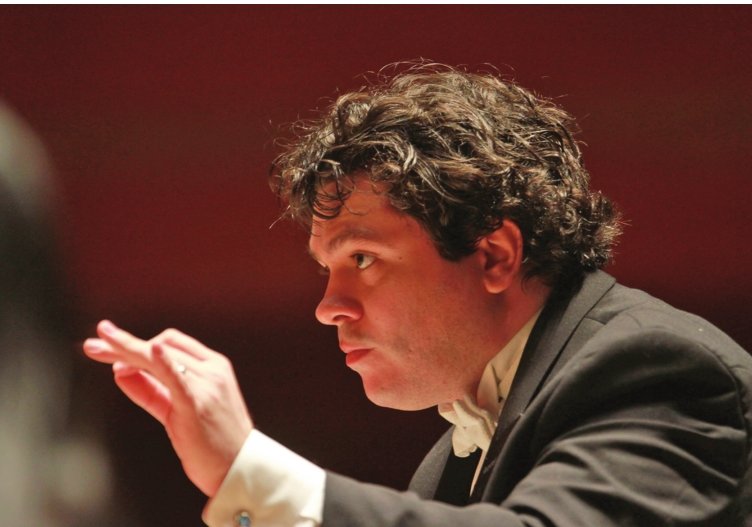
Lovemaking should linger; catastrophes ought to be quick. That’s how conductor Cristian Mâcelearu sees Ravel’s hypnotic, horrific masterpiece, “Bolero.”
“A seductive dance begins as a thought, turns into reality and leads to complete destruction,” he said. “It maintains a dreamlike state all the way to the end, and then becomes a nightmare.”
You’ll never hear a rote performance from Mâcelaru, 38, and the youthful National Symphony Orchestra of Romania, due to arrive at the Wharton Center Sunday.
It’s the first time any Romanian orchestra has toured the United States, part of a year-long celebration of the country’s 1918 unification.
The musicians — most of whom are younger than the maestro — perform with a folk-inflected, heady spice that steamed up from a small Central European country in the 20th century, slipped under the lid of Communist rule and exerted a disproportionate influence on music around the world.
You expect that spice to explode from Georges Enescu’s “Romanian Rhapsody,” leading off the bill Sunday, but it also works wonders for Richard Strauss, Tchaikovsky and Ravel.
“In ‘Bolero,’ you can play what’s on the page, but that’s a 2-D representation,” Mâcelaru said. “The melodies have a sensual element between the notes. There’s a pulse and a groove that creates this inevitability of going someplace you don’t want to go!” Mâcelaru likened the orchestra to a rock band that plays for fun between meat-and-potatoes gigs. The group started 10 years ago as a youth ensemble, along the lines of Venezuela’s famous Simon Bolivar Orchestra. By now, the earliest cohorts are in their early 30s, but they had such a great time getting together that they still come together once a month or so to do a tour, a festival, a CD or some other project.
“Being together with your friends, when you know it’s only for a week or 10 days — it’s a huge difference in how the music is made when you really want to be there,” Mâcelaru said.
The tour also gives Mâcelaru a rare chance to be the oldest person in the room. Usually, he’s herding the greatest orchestras in the world, like the New York Philharmonic or the Chicago Symphony, where he got a big break substituting for an ailing Pierre Boulez in 2012.
“It’s just boundless energy, this feeling of excitement that’s infectious,” he said. “It’s also like a high school reunion, nostalgic and warm.”
Mâcelaru has enjoyed a stunningly fast ride to the world’s top orchestral podiums, from Berlin and Rotterdam to Los Angeles, London and Philadelphia, where he now lives, and it all began with a 1997 scholarship to Interlochen in northern Michigan.
Not only did the scholarship get Mâcelaru out of Romania, where international opportunities were limited, but it also turned his life upside down. Mâcelaru came to Interlochen as a violinist, but a remarkable conducting teacher, John Ross, had other notions.
“Conducting was the furthest thing from my mind,” Mâcelaru said. “I discovered conducting as a great art form and a way I could express myself.”
Mâcelaru’s mission on the American tour is to explore the cross-currents linking Romanian music, represented by beloved native son Georges Enescu, with the music of Romania’s heavyweight neighbors, France, Germany and Russia.
Criss-crossing armies trampled back and forth across central Europe in the 20th century, with tragic consequences, but Romania’s central location also turned it into a musical melting pot with influence out of proportion to its size. Add rich folk traditions to the mix and it’s no wonder Romanian musicians have been welcomed around the world.
“In every orchestra I go to, from the Berlin Philharmonic to smaller orchestras, I always meet Romanian musicians,” Mâcelaru said. “It astonishes me because it’s not a terribly big country. So many of them have managed to make lives and careers outside of Romania and I wanted to show some of that.”
The orchestra took the cultural crossroads theme to extremes Friday by joining forces with the Jazz at Lincoln Center Orchestra in New York to play a major opus by Mâcelaru’s friend and frequent collaborator, Wynton Marsalis.
Marsalis’ Symphony No. 4, “The Jungle,” is a huge, densely layered portrait of New York City, blending jazz and classical music. The massive first movement, cut from the symphony’s premiere in 2016 for length, got its world premiere Friday.
It added a layer of complexity to the tour, but Mâcelaru couldn’t resist the opportunity.
“It’s a way for us to understand jazz, American folklore, and open the way to a collaboration with arguably the greatest artist alive, in both the jazz and classical fields,” Mâcelaru said. “The thought of our two groups being together on the same stage, performing music written by Wynton — who would have thought of that a few years ago? But crazy things happen like that.”
National Symphony Orchestra of Romania 6:30 p.m. Sunday, Jan. 13 Wharton Center Cobb Great Hall $29 and up (517) 432-2000
Support City Pulse - Donate Today!
Comments
No comments on this item Please log in to comment by clicking here